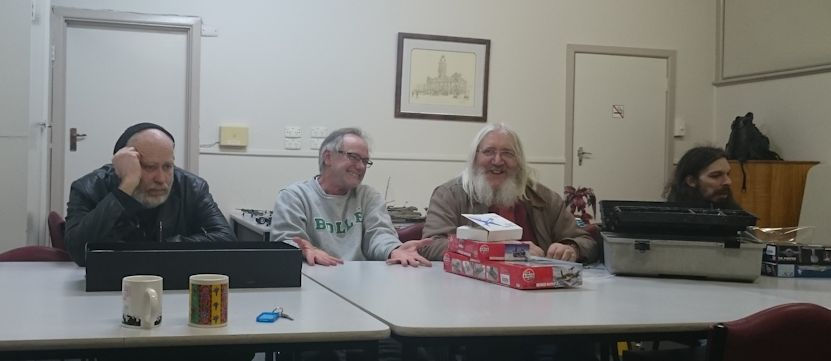Deep thinking at the modelling club
(October 2015)
Here is a photo taken at our most recent MoB meeting by Master Sean. It shows four MoBsters, innocently it seems, sitting at a table. Master Rod, on the right, is in a state of deep mystical meditation on the completion of his latest modelling project. Master Zim, on the left, is looking glum because he has been struck down by the lurgi and wonders if death might release him from his torment. In the middle, Masters Mark and Leigh are, despite their cheerful appearance, debating a matter of serious philosophical import. It should be noted here that both Masters Mark and Leigh hold degrees of Doctor of Philosophy and are thus qualified to talk about philosophy, sort of. Master Zim also holds a PhD but he is an engineer, and we all know what engineers think.

So, what is this philosophical point that our two philosophers are debating? Since this is a meeting of scale modellers you will not be surprised to learn that it is about the philosophy of modelling, specifically the appearance of a completed model. Let me explain, and if you’re not interested in such idle chatter I’m sure you will find something more interesting on the following page.
Dr Mark holds that the important thing about a completed model is that it should reflect or show the truth of the item that it represents. Thus, a model of a Bf108G-6 flown by Oberleutnant Joe Blogs on the afternoon of 22 July 1944 should look as much like the real think as possible. He argues this from the theoretical perspective of Neorealism, which, as I understand it, grown out of the Italian film industry of the 1950s. It posits, among other things, that a thing should show the reality or truth of its situation. This suggests that just because something looks real, it is real. A possibly valid perspective. I point out, however, that this is at basis an Italian concept and Dr Mark makes models of German aeroplanes. Need I say more.
I, on the other hand, argue that the idea of truth itself is problematic and contested. Therefore, the idea of a model that shows the truth of a subject is also problematic. All knowledge is provisional and so it is not possible to know the truth of Oberleutnant Joe Blogs Bf109G-6. Just because you have a side colour profile of said aeroplane in a book you brought at Hylands, and a decal sheet, does not make it true, though perhaps true philosophically.
Of course, we should not confuse the concepts of truth and beauty, although it is possible, though a fallacy, to say that something is true because it is beautiful. But I digress.
I argue that, to do some damage to the saying of that great twentieth century political philosopher, Mao, truth – in a modelling sense at least – grows out of the box of the kit from which the model is made. Thus, the truth of a model grows not out of the model which the modeller attempts to make, but out of the kit from which the model was made. Thus, in a real, but also philosophical sense, a model is in truth always a Hasegawa or an Academy Bf109G-6. I point out, to bolster my argument, that the philosophical basis of this argument is French and I make French models. I rest my case.
Leigh Edmonds